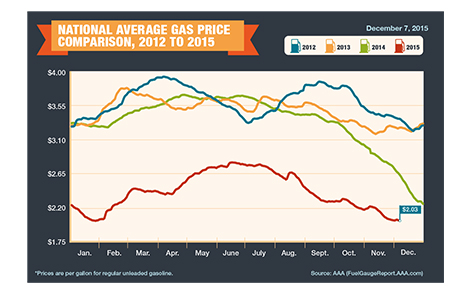Low Prices Benefiting Drivers...
Average Gasoline Price Lowest Since 2009

The national average is less than a penny higher than the 2015 low (January 26), and should soon fall below the $2 per gallon mark for the first time since 2009. Pump prices have fallen for 29 of the past 31 days, and today's average price of $2.03 represents a savings of one cent per gallon on the week and 19 cents on the month. Significant yearly savings persist, and gas prices are discounted by 65 cents per gallon compared to this same date last year.
During the winter months demand for gasoline typically declines, and pump prices tend to move lower as a result. Following a busier than usual fall maintenance season at refineries, the U.S. Energy Information Administration is reporting that refinery production is outpacing both 2014 and current demand. U.S. crude oil stocks are also within striking distance of an all-time high, and as a result, questions about continued production and storage capacity are beginning to arise. This combination of ample production and increasing gasoline inventories are likely to keep gas prices relatively low, and barring any unforeseen shifts in market fundamentals, averages are likely to continue to decline leading into 2016.
South Carolina ($1.81), Missouri ($1.81) and Oklahoma ($1.83) are the nation's least expensive markets for gasoline, and consumers in a total of 23 states are paying an average below $2 per gallon.
Drivers nationwide are benefiting from monthly savings at the pump, largely due to gasoline production returning to levels not seen since the beginning of the seasonal turnaround. Gas prices have fallen by double-digit increments in 35 states and Washington, D.C. since one month ago, and motorists in 14 states are saving more than a quarter per gallon in the price at the pump over this same period. The largest month-over-month drops in the price of retail gasoline have been in the Midwestern states of Michigan (-53 cents), Wisconsin (-44 cents), Indiana (-37 cents) and Illinois (-36 cents).
The relatively low price of crude oil is helping to sustain year-over-year discounts in the price of gasoline nationwide. Retail averages are down more than 50 cents per gallon in 48 states and Washington, D.C., and motorists in a dozen states are saving at least 75 cents per gallon versus this same date last year. Alaska (-$1.05) and Hawaii (-$1.00), two of the nation's most expensive markets, are also the only two states where drivers are saving $1 or more per gallon compared to one year ago.
OPEC's decision at its meeting last week to sustain its current production levels sent ripples through the global oil market and has contributed to lower oil prices. The cartel is not scheduled to reconvene until June 2016, and in the interim the imbalance between supply and demand will likely persist. Market watchers will remain focused on the Federal Reserve, which is expected to raise interest rates on the heels of a strong U.S. jobs report. A higher interest rate typically leads to a stronger U.S. dollar, which makes oil relatively more expensive for those holding foreign currencies. The combination of these factors has the ability to further exacerbate the global oil market's state of oversupply and keep downward pressure on prices.
The domestic oil market is also reflecting signs of oversupply. Both crude oil and gasoline inventories are approaching record levels even as lower prices impact exploration and production. According to the latest data from the Bureau of Labor Statistics, the domestic oil and gas extraction sector lost upwards of 2,400 jobs during the month of November. This follows the October report which showed the sector shedding approximately 2,700 jobs.